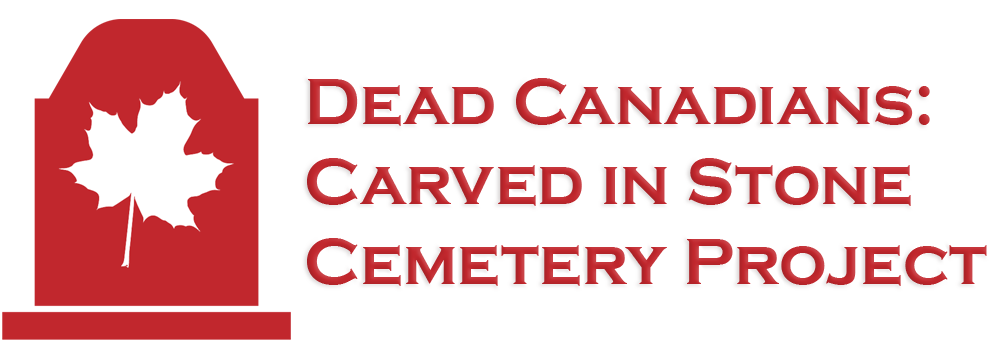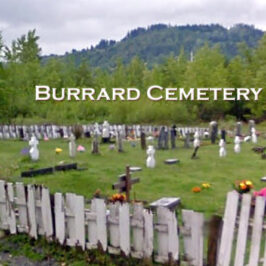Riverside Cemetery is located on Smith Drive in the North East corner of Neepawa.
There are well over 2500 graves covered each summer with flowers, under the perpetual care program. It is said that there are more flower covered graves at than in any other graveyard in North America. The cemetery is peaceful and picturesque with the many flower beds, flower covered graves and plentiful trees groomed to perfection.
Riverside Cemetery is the final resting place for famous author, Margaret Laurence and contains the family burial plot for the founding family, the Grahams. Riverside Cemetery is the furthest west burial place for a victim of the sinking of the Titanic.
The cemetery is best known for the Davidson Memorial, or more often called the Stone Angel as made famous by Margaret Laurence’s book of the same name.
Neepawa, Manitoba’s Picturesque Riverside Cemetery
by local historian, Cecil Pittman
Nestling quietly on an escarpment above the winding Whitemud River and overlooking the well-groomed golf course rests Neepawa’s Riverside Cemetery. It is located on land once owned by Peter Graham who first homesteaded there and received title February 23, 1885. The remains of the house foundation can still be seen protruding out of the deep prairie grass and small shrubs and trees that have slowly enveloped the homestead remains over the years.
The first burial took place December 1877 and was that of James Graham, the 99-year-old father of Peter. This area still remains for Graham family burials aslong as there are plots available. The property changed hands when Bethuel Hamilton purchased the land July 19, 1890, and again when Rhoda Ann Law, who had obtained it from Hamilton, sold to the Town of Neepawa on May 3, 1898. This was to become Riverside Cemetery. The town also purchased additional land to the west in 1931 from John Barry Fleming.
One cannot help but be impressed upon entering the cemetery. The towering spruce trees and the smaller ones that have been sculptured to perfection greet the many visitors. In the summer months the cemetery takes on a new look. Like a massive carpet, the flower-covered graves spread out before your eyes. In the 1950s, the Parks Board introduced a program to allow people to purchase perpetual grave care. There are over 2,500 graves with this type of service. This, along with other graves that are maintained by individuals, is a magnificent site to behold. Many people from different parts of the world who have visited the cemetery often remark that Riverside is the most beautiful cemetery they have ever seen.
As in any cemetery, there are monuments that have created extra interest and Riverside is no exception. Entering the cemetery from the west gate, you approach Hon. John Andrew Davidson’s memorial, erected in 1903. Davidson was one of Neepawa’s earliest settlers, coming to Neepawa in 1881. He and his brother-in-law, Jonathon J. Hamilton, established a mercantile business here. They founded the present Town of Neepawa. John Davidson had the distinction of being the Provincial Treasurer of Manitoba. His palatial residence, better known as “”The Castle:’ can be seen as you travel up the eastern approach to town. His monument has also taken on the name “”Stone Angel”” made famous by the novel of the same name written by world-renowned author Margaret Laurence, who was born in Neepawa.
As you travel further east, you will notice the Christopher Mather stone. He was a former editor of The Register, one of Neepawa’s first newspapers. Erected in 1893, it is constructed in the shape of a tree, complete with sawed off limbs protruding from the bark-covered tree stump.
On the south side of the cemetery is the final resting place of Margaret Laurence. Her gray granite headstone is located in the Wemyss family plot, overlooking the Neepawa Golf Course.
To the north, the Lewis Hickman grave can be found. He is the only victim of the Titanic disaster buried in western Canada. His brother, Leonard, worked on the Honeyman Farm in the Eden District, north of Neepawa. He returned to England, December 1911, to encourage his brothers, Lewis and Stanley and two of their friends to immigrate to Canada to find employment. Unfortunately for them, the ship they were to return on could not sail due to a shortage of coal brought on by a miners strike and the amount that was required for the Titanic on its maiden voyage. They all transferred onto the Titanic and all five perished in the disaster.
To add to the mystique of the Hickman story, it was discovered on the day of the funeral, the body of Leonard, who had been identified by an Eden Forester’s lodge card found in his coat pocket, was actually his brother Lewis. The Knox Presbyterian Church was full to capacity so it was decided, after a short discussion with the Minister, to proceed with the service, burying Leonard. The people were advised of the mix-up a few days later. The memorial at the grave site was purchased by Neepawa and district citizens who felt the shock of the disaster and the loss of a friend. A small marker with the letters L. H. was unearthed in 1998 when the sod was removed in preparation for perpetual grave care. It has been placed at the base of the grave.
Winding your way out of the cemetery, you pass the military headstones. Among them, the marker of Trooper William Wright, who was killed in the November 21, 1950 Canoe River train crash in British Columbia. The soldiers were on their way to the Korean Conflict when the two trains crashed head on, killing 17 soldiers, members of the 2nd Regiment Royal Canadian Horse Artillery.
One would be remiss to not mention the immense contribution the late Nick Kawka made during his 25 years as caretaker of Riverside Cemetery. The pride he maintained in his job was very evident over the years. It is mainly through the efforts and initiatives he established that produced the picturesque landscaping that presently exists. At the cemetery today, caretaker Jack Follows is carrying on this tradition. No large machinery is used in the cemetery and all graves are dug by hand, both in the summer and the winter.
The epitaphs on the monuments can have real meanings, such as the “Black Stone” that reads:”Reader behold as you pass by / As you are now, so once was / As I am now, so you shall be / Prepare in life to follow me.”
Some also have a little humour involved. Vernon McKinnon, a former Spitfire pilot with the RCAF during World War II was known to have enjoyed a few beers with his friends in the local taverns. His wife Hughene thought it appropriate to have a small marker with the inscription “Time Gentlemen, Please” placed at the foot of his grave. This was the bartender’s call to let the patrons know the bar was closing.
As you leave the cemetery, pause for a moment. Listen to the wind whispering through the needle laden bows of the spruce trees, the birds chirping and the lonesome whistle of the CPR train sounding in the distance as it approaches town. The warm summer winds scented by the thousands of flowers throughout the cemetery gently blows against your face -this is truly tranquility at its finest



Leave a Reply